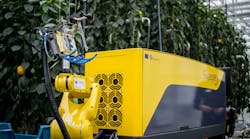New Agriculture Robot SWEEPER Lends a Hand in Pepper Picking
Finding efficient, affordable labor to pick and sort crops has long been a problem for the agricultural industry. This past September saw the introduction of a robot called SWEEPER for picking sweet peppers—the industry’s newest attempt to ease its labor burden via automation.
The robot was developed by a consortium between BGU, Wageningen University & Research, and pepper grower De Tuindershoek BV in the Netherlands; Umea University in Sweden; and the Research Station for Vegetable Cultivation and Bogaerts Greenhouse Logistics in Belgium. The SWEEPER project has received funding from the European Union’s Horizon 2020 research and was introduced at the research station for vegetable production at ST. Katelijne Waver in Belgium.
SWEEPER was designed to operate in a single stem row cropping system, with non-clustered fruits and little leaf occlusion. Within these conditions, the robot can harvest ripe fruit in 24 seconds with a 62% success rate. The BGU used advanced computer vision methods to improve the robot’s ability to detect ripe produce, which has determined the robot’s hardware and software interfaces.
According to Polina Kurtser, a Ph.D. candidate in BGU’s Department of Industrial Engineering and Management, using robots to harvest fruits and vegetables will revolutionize the economics of agriculture industry. “The Sweeper picks methodically and accurately,” she says. “When it is fully developed, it will enable harvesting 24/7, drastically reduce spoilage, cut labor costs,S and shield farmers from market fluctuations.”
The market for robots in agriculture has been on the rise, primarily due to the aforementioned labor issues. According to a survey conducted by the California Farm Bureau Federation, 55% of farmers have experienced employee shortages. To combat the lack of labor, two-thirds of farmers surveyed reported using or starting to implement some form of mechanization into their production process.
Earlier this year, Agfunder News reported that the harvesting robotics market reached $5.5 billion from early adopters alone. In a market research report conducted by Alpha Brown, this market share only represents 3% of the growers, mainly local and independent farmers. The report showed that 27% of the 1,300 growers surveyed are considering purchasing a robot to help with their harvesting needs. Their main concerns are time-saving and efficiency to ensure an on-time harvest.
For SWEEPER, more research needs to be conducted to increase its speed and harvest success rate. Following the latest test results, the researchers behind it expect the robot to be commercially available with the next four to five years. This would be a boon to farmers in North America, the second largest producer of sweet bell and chili peppers in the world with 31% market share. Europe accounted for more than half of the world’s pepper supply at 53.2% market share.

